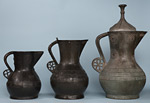items » household plate
Household plate
The silver-gilt and silver plate for use in the 'hostiell du roy ', the king's household, is listed separately in the treasure roll. These pieces were not intended for the intimate setting of the king's own chamber, but were for the noble and gentry members of the king's familia (his retainers and officers), eating at court.
Richard had a very large household by the end of his reign. Their numbers meant dozens of eating and drinking vessels were required at any one time, as well as items for the kitchen. The heads of the different household departments were directly responsible for all this silver. They in turn answered to the treasurer of the household.
Silver-gilt comes first in each section, but there is always more plain silver. Vessels of base metal were also in use and can be found in other types of record, but they had no place in the treasure roll. The arrangement of this section of the treasure list is by household department. The contents are summarised in the order of the document.

Three jugs, copper alloy. From left to right: The Wenlok jug (Luton Museum, Wardown Park); The Robinson jug (Victoria and Albert Museum); The Asante ewer (British Museum)
Larger image (26KB)
Pantry
The list begins with the pantry, saltssalt - container for salt, often with a decorative construction supporting the salt-cellar , chandeliers and spoons. Next comes the buttery with pots (jugs) of three sizes from a gallon down, cups and ewers (see the Asante ewer) . In the spicery were spice-plates, large chargers and individual dishes for the spices and fruit served ceremonially at the end of a meal.
Kitchen and scullery
The kitchen was answerable for a large number of silver vessels, cauldrons, pots, a gridiron, a ladle and skimmer and two spits. The sculleryscullery - department of the royal household charged with the care of plates, dishes and saucers (a word which has changed its meaning), could muster no less than seventy-one large silver-gilt and silver serving dishes, and three hundred and two individual dishes.
Saucery
The saucery needed a lesser number of saucers (shared sauce containers). It had at the time the list was made one hundred and sixty-six. In charge of the ewery were basins, ewers and a warming dish. The almonry, the department which distributed surplus victuals to the poor, had a capacious silver-gilt almsdish and a somewhat larger silver one.
Broken silver from the forfeitures
At the end of the itemised paragraphs are some further notes about large amounts of broken silver and what was being done with it. It was valued at one pound in money per pound in weight (see weights and coinage). Silver vessels weighing more than 702 lbs. had been seized from Thomas Arundel, archbishop of Canterbury, when he was exiled in 1397. Some had been remade for the buttery.
Household plate is listed on membrane 27 of the treasure roll.
